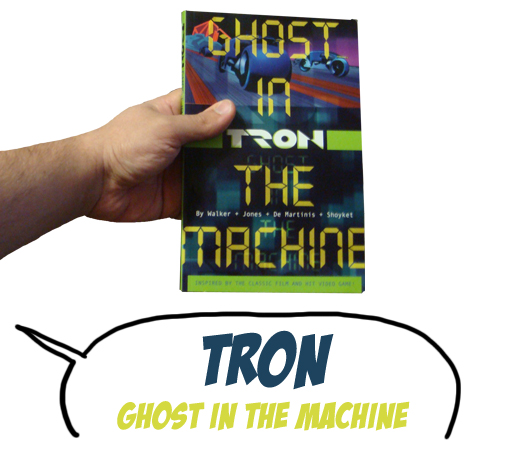Tron's not only a series of movies and games.
Following it's cult status in the culture, various comics were published over the years.
Not as much as, say, Star Wars.
But some interesting pieces were produced that fans might want to check out!
Today, we'll check out the first series that came out some years ago!
NOTE! Read my review or play the videogame TRON 2.0 before hand!
Comic title: Tron: The Ghost in the Machine
Art by Louie De Martinis, Michael Shoyket & GURU-eFX
Story by Landry Walker & Eric Jones
Published by SLG Publishing
From 2006-09
Lineup Tron
Format: Collects the six issue miniseries.
As a big science fiction classic in the popular culture, it always surprised me how there never had been any Tron comic book adaptation for a quite long time.
That is, until the quite successful videogame Tron 2.0 brought back the attention for this "franchise" (which wasn't really one since before there had been only a single not that commercially successful movie) .
Around the early 2000s, with Tron 2.0 still fresh in everybody's mind, the publisher 88 MPH solicited a mini-series titled Tron 2.0: Derezzed....which in the end, never came out.
(88 MPH was struggling financially, near bankruptcy for quite some time, which made them also cancel a bunch of other books like the quite demanded Ghostbusters series)
This comic was cancelled before any issues were released...
Zoom back to 2005 now, SLG announced a new comic based on Tron, which ended up being this very one.
A big storyline continued the now kinda distant Tron 2.0, written by Landry Walker .
This comic ended up looking like a strange patchwork, kinda fitting for its plot, but pretty strange to jump into at first glance.
The first 2 issues were beautifully drawn, almost painted, by Louie De Martinis. It has a very odd surreal look, perfect for a modern take on The Grid. the following issues/chapters, by Michael Shoyket have a much more traditional comic book look, cartoony on some segments and definitively simpler.
Reading it as a whole, it doesn't detract from the content since the storyline is just as "patchworked".
Why this change in creative team and style? Well, I suspect it's because SLG simply regained what had previously been done for 88 MPH before, behind the scenes.
The authors never really shined light on everything that happened on this book and all its details, but that's what I think.
Now, what about the comic book itself?
Jet's back inside the Grid!
Kevin Flynn had discovered a digital universe in the 80s.
With Tron, a software designed by his best friend Alan Bradley, he had conquered and mastered the Grid.
Years later, during Flynn's disappearance, the son of Alan, Jethro Bradley ended up as well inside the computers while he was visiting Flynn's company ENCOM. After fighting the corruption and regaining access to Ma3a, a new program designed by Alan after the inciden from the 80s, he was able to access the Tron Legacy code and escape through the real world...or did he?
This story takes place about 6 months after Tron 2.0.
Jet was back, living as much of a normal life as he could..but things weren't the same anymore.
Was he really living now outside the computer?
Was this all part of the Grid's sub-routines making him think that while he was still trapped inside that world?
The difference between what was happening in the outside world and the memories of his adventures inside the Grid started to blur more and more.
A moment he seemed to be outside, in the real world..then the next were those flashbacks he was having or was it the present?
One day while he was running away from the police (or was it in the past?) Alan gets shot...killed..by the police running after him or was it Jet himself using the gun?
Things aren't what they seem to be...
Once Jet is able to get in the Grid, real or not, he will be able to make sense out of everything...
...Or will he?
ACTUAL SCENE FROM THIS COMIC!! No kidding!
You probably got that from my summary above, the story is a bit confusing and gets a bit sketchy for some parts...
Probably because of it's difficult production.
Though I remember reading the collected trade paperback (or all 6 issues back to back) rather than checking one or two of these issues.
It's a very dense and surreal story.
And is it really a bad thing?
In reality, I find this story pretty well crafted.
Landry Walker wrote a fantastic piece exploring and playing with Tron's universe.
Tron, unlike Star Wars, or Buffy the Vampire Slayer and many more cult icons didn't get much explored apart from a modern (well liked) videogame and finally nowadays a big budget sequel.
Rather than "expanding the universe" like most adaptations tend to do this book plays a bit with Tron's concepts and abstraction.
Tron's universe is in fact a pretty abstract one to begin with. If someone would really get inside the computer would it look stylish, like an 80s 8-bits game like Pong or all modernized like a "next gen" videogame? What if the world would be presented and reflected by that very same person exploring it? Are there some rules? How would we perceive such binary world with our senses?
The Ghost in the Machine is a pretty strange odd and unique experience. Affected by and affecting Jet Bradley - then, current main character of the Tron universe, even ~5 years later since his first and last appearance.
There's a lot of symbolism and metaphors (visual metaphors even). From Jet's very own "Wonder Land" through his escapism into his very own shaped reality we know as the Grid.
DEREZZED!
The book's visual art changes and moves around, as it change artists and content as well.
The confusion, what is real...what isn't... isn't clearly defined - thanks to all that.
Many questions are posed, doubts are created in the reader...nothing is clearly explained in the end.
For Tron fans that might not pick this one up, here's some spoilers and questions to ponder upon:
Spoiler:
As you can see it's not a straightforward story, it's something to think about, maybe re-explore a second time over after a first read.
Overall, this is not what I'd call a mainstream comic.
Tron wasn't super popular back then (until the big blockbuster sequel Tron Legacy). This book served as a good opportunity to play with the abstract computer science that populates the Tron universe. Its semantics.
A pretty original follow-up to the classic movie and/or the videogame.
Though you'll really need to know one of those or both to really get it, it isn't reader friendly!
I'd say, it is a work for fans mostly, if you're interested in exploring the more metaphysical parts of the Grid. Hardcore fans and the likes~
Nerd-note: If you consider Tron 2.0 part of the continuity (like me!) or not with the new sequel (and vis-versa!) this book can still be perfectly canon with both ideas since as the decisions and choices regarding some events are left to the reader!
I give it:























Hey, thanks for the review. Made my day to see the drawing of Jet with the bunny. I should clarify one thing though: The comic was co-written with Eric Jones. Anyway, again... thanks for the review.
ReplyDeleteWait, I just noticed that you included a credit for Eric at the very beginning. I missed that and only saw the other parts later. Nevermind.
ReplyDeleteWow! The co-writer of the book himself commenting over here! Thanks^^
ReplyDeleteYeah, I kinda forgot to add some lines regarding Eric Jones, though as you noted, I had mentioned his name in the credits ;)